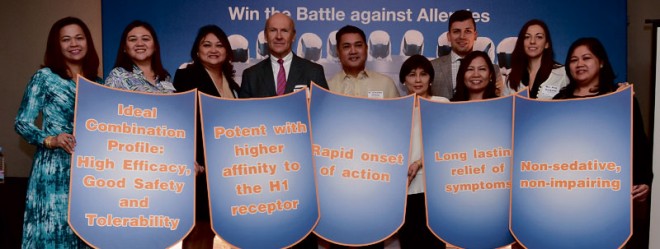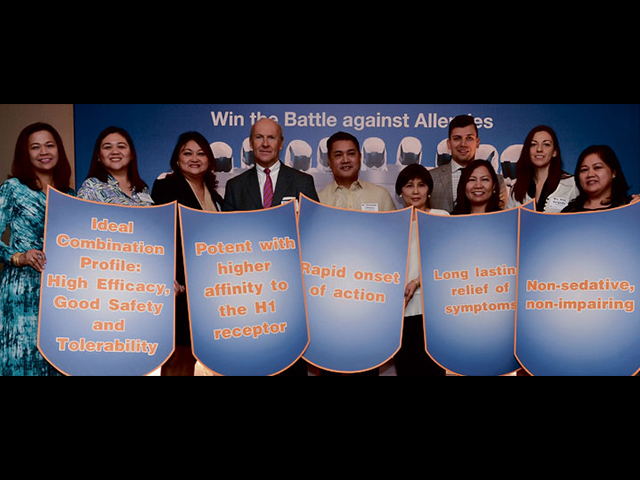
If you have been sneezing again and again, if your eyes are often watery and itchy, or if your nose is runny or stuffy due to congestion, you may have allergic rhinitis.
Allergic rhinitis is an allergic reaction that affects two out of 10 Filipino adults, according to the National Nutrition and Health Survey in 2008. It happens when the body’s immune system becomes sensitized and overreacts to certain allergens that normally do not cause problems to other people.
Although allergic rhinitis is also called hay fever, you do not need to have a fever, and you do not have to be exposed to hay, to trigger any symptoms. There is no cure for allergic rhinitis, but you can manage an attack.
“The availability of a new antihistamine molecule that offers enhanced efficacy, safety and tolerability is welcome news to the substantial number of Filipinos who suffer from allergic rhinitis and urticaria,” said Dr. Jovilia Abong, past president of the Philippine Society of Allergy, Asthma and Immunology, at the launch of Bilastine, a second-generation antihistamine from Menarini Philippines Inc.
Bilastine is said to provide fast and effective symptomatic relief of allergic rhinitis and urticaria (hives), in which swollen red bumps appear on the skin as a result of certain allergens. Bilastine is a nonsedative, no-drowse and non-impairing drug, so it does not interfere with your daily activities.
Rapid relief
“Bilastine is a once-daily antihistamine tablet that is endorsed by international therapeutic guidelines. It has the ideal combination of high efficacy and a good safety and tolerability profile. It provides rapid relief of allergic rhinitis and urticaria symptoms, enabling patients to enjoy better quality of life,” said Dr. Ralph Mösges, an otorhinolaryngologist (ENT specialist) and allergologist.
Mösges is also a professor for Medical Informatics and chairman of the Institute of Medical Statistics, Informatics and Epidemiology, University of Cologne in Germany.
In the Philippines, Abong said, the three most common aeroallergens are house dust mites (87 percent), house dust (83 percent) and cockroaches (41 percent). House dust is especially hard to manage this summer, when the land becomes extremely dry, blowing dust everywhere.
Other aeroallergens include mold spores, cat/dog hair/dander, and pollen from grass, weeds and trees. Symptoms, however, may also be triggered by common irritants such as perfumes or hair sprays, laundry detergents, cosmetics, cigarette smoke, cleaning solutions, chlorine in swimming pools, car exhaust, or wood.
When you inhale any of these allergens, your immune system reacts with symptoms such as runny nose, itchy and watery eyes, sneezing, itchy eyes, mouth or skin, and stuffy nose.
Over time, allergic rhinitis causes fatigue due to sleep deprivation caused by nasal obstruction. Patients have difficulty sleeping, waking up in the middle of the night or generally lack a good night’s rest. When this happens, it affects productivity.
“During the study, participants between attacks reported a productivity of 89 percent, but which goes down to as low as 65 percent during attacks. This loss in average productivity represents a significant economic cost to the employer, to the country, to the sufferer and to the families,” Abong said.
Missing work
Nearly half of the participants, he added, reported missing work or their job performance affected during an attack in the past 12 months.
The best way to manage allergic rhinitis is to make changes in your home and behavior to avoid triggers, such as wearing glasses or sunglasses when outdoors to keep the pollen out of your eyes, or using mite-proof bedding covers to control and limit exposure to dust mites.
Hanging clothes, towels and bed sheets outdoors to dry may also attract pollen that clings to the cloth. Clean your floors with a damp mop instead of sweeping. Dehumidify your room to control molds, and wash your hands after handling pets (or any animal) and keep them out of the bedroom if you can help it.
“Because it is likely that patients with allergic rhinitis will have generally sensitive airways, allergy experts recommend that all patients with allergic rhinitis and/or sinusitis who are seeing a doctor should be tested to see if there is also evidence of underlying asthma,” Abong said.
Aside from avoiding allergens, medical intervention is also necessary to manage an attack. Allergen immunotherapy, while expensive, is a long-term treatment that reduces symptoms, reduces the need for medication, improves the quality of life, prevents the development of asthma, and actually has the potential to alter the natural course of the disease.
For most Filipinos, however, the easier and affordable way to manage allergic rhinitis is through pharmacotherapy. There are 600 million people worldwide who struggle with allergic rhinitis; one out of four experience acute urticaria at least once in their lifetime.
Bilastine addresses both conditions.
In a situation where allergens are unavoidable, pop an antihistamine beforehand to protect your immune system. Symptoms are normally much harder to manage at the onset of an attack.
Bilastine is available at all leading drugstores.













































